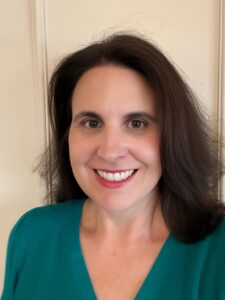
Before moving to southwest Detroit, Felisita Roland lived in Zip Code 48209 in Detroit’s Delray neighborhood.
Population: 28,667
Unemployment rate: 15.9%
Michigan unemployment rate: 3.7%
Black: 8.8%
White: 18%
Hispanic or Latino: 71%
Other: 2.2%
Median household income: $15,893
State median household income: $63,202
Sources:
City Data / Income by Zip Code
Felisita Roland couldn’t imagine a more perfect wedding gift from her parents: a home just a few doors away in Detroit’s Delray community. She said her parents felt it was a place she would be happy – and a way to build generational wealth for her family.
Roland’s parents moved from Chicago to Delray in 1978. They purchased and fell in love with their home on Sire Street in 1984, where she grew up. After her parents passed, Roland moved back into the family’s home.
Many neighbors left the area over the years as pollution increased, and houses in the neighborhood were sparse.
But those who remained made an effort to care for each other, Roland said.
“The neighborhood wasn’t great,” she said. “The neighbors were phenomenal.”
Although small for her growing family, Roland said the home served them well. She even grew accustomed to the constant rattling of windows caused by the local truck depot and blaring horns from the train tracks across the street.
When news of the massive Gordie Howe Bridge development came in 2017, Roland and her family attended community meetings hosted by the Delray Community Center, where residents were briefed on what to expect.
She learned the project would drastically transform Delray, placing the footprint of a massive international bridge crossing squarely in the neighborhood and bringing in additional truck traffic. The second bridge span will double truck traffic — from an estimated 10,000 trucks per day to 20,000.
Residents living near the bridge are exposed to significant noise and air pollution. In 2017, the City of Detroit established the Bridging Neighborhoods program in response to expected health and quality of life impacts on Delray residents.
The program used funds from a $45 million community benefits deal with the Windsor-Detroit Bridge Authority to establish a home improvement and relocation fund for impacted residents.
The bridge’s impact zone includes residents already dealing with significant pollution from the nearby Marathon plant and other industrial businesses. Bridging Neighborhoods Program Director Rico Razo said the effects of the city’s wastewater treatment plant and surrounding industries can make life unbearable.
“If you stand by the Delray Recreation Center in the hot summertime, where the wastewater treatment facility is, you see plumes of orange smoke going up,” Razo said. “I don’t know if you ever get used to it, but your eyes will water, and you smell the odor in the air.”

Part of the community benefits agreement included funding to support monitoring of the health impacts of bridge construction and operations over time through a three-phase Health Impact Assessment.
University of Michigan researchers completed and published the study in 2019, which found significantly higher self-reported asthma rates among children living within 500 feet of trucking routes.
That finding is consistent with national literature, according to Dr. Amy Schulz, a University of Michigan School of Public Health professor and a team member conducting the survey portion of the HIA.
“That area of Detroit has some of the highest concentrations of exposure to cancer and respiratory risks that are attributable to air pollution – even before the bridge’s construction,” Schultz told Planet Detroit. “It is an area that experiences the cumulative impacts of multiple polluting sources that are likely to affect the resident’s health as more trucking comes into that area.”
The HIA made several recommendations for mitigating health impacts, such as restrictions on truck idling, requiring setbacks and buffers between areas of high truck traffic and residential areas and schools and installing indoor air filters, among other measures.
The study also recommended the types of home improvements covered under Bridging Neighborhood’s home improvement program.
“There are things that can be done to reduce those exposures,” Schulz said. “Things like windows and doors where you can potentially reduce air pollutants getting inside the house.”
Expanded healthcare access was also recommended in the report.
“We heard a lot from people already struggling with asthma or chronic heart disease, and they were very concerned that they were going to see exacerbations of those health issues as traffic increased,” Schulz said. “Many of them were very concerned about not having health insurance or not having adequate health insurance.”
Noise pollution is another significant factor that impacts health, according to Dr. Richard Neitzel, a professor at at the University of Michigan’s School of Public Health.
Neitzel said that people living along a major roadway or traffic flows are exposed to noises around 70 decibels consistently.
That may not seem loud (it’s just a bit louder than talking at arm’s distance from someone), but when people are exposed to that level of noise over long periods, they can develop health conditions like hearing loss, high blood pressure, heart attacks and strokes. There’s also growing evidence that noise exposure can lead to poor learning outcomes in young children and dementia in older adults.
The cardiovascular impacts, Neitzel said, likely happen because noise is a constant source of stress.
“As the traffic and noise pollution goes up, the risk of those things is going to go up as well,” Neitzel said. “Noise is just a general systemic stressor. If you’re living all day, every day, in high noise, your body is constantly in that fight or flight mode. It becomes essentially a toxic condition for your body.”

Eligible residents can choose from a list of Detroit Land Bank Homes in their chosen neighborhood. The home is then renovated to fit safety and environmental standards.
Razo said that most of the 71 completed home swap participants have so far requested to live in Southwest Detroit and Warrendale. Through seasonal door-knocking campaigns, Razo said the program has identified at least 300 occupied homes in the eligible impact zone.
However, some residents remain committed to staying in Delray, with at least 90 enrolling in the Delray Home Improvement Program, which provides eligible residents up to $20,000 for home improvements.
“There’s a variety of reasons why people want to stay,” Razo said. “I think some people feel like they would feel disconnected (in another neighborhood).”
Razo said home improvement participants can choose any repairs or renovations they feel are needed, within budget.
“Homeowners selected everything,” he said, “whether it’s a screened-in porch, porch rebuild, demo of something that may be collapsing in their backyard, siding, windows, plumbing HVAC, you name it, we’ve done it.”
The program also awarded 174 properties within 300 feet north of the I-75 freeway with renovations to mitigate against air quality concerns and noise pollution, including windows, air filtration and insulation.
When she first heard about the city’s home swap program, Roland said she dismissed the idea out of hand.
“Initially, I didn’t want no part of it. Delray was my family at that point. And just the thought of going to a whole new area and starting all over again didn’t appeal to me,” she said.
It wasn’t until her mother and brother-in-law passed from cancer five years later that the Rolands decided it was time for a new chapter. They’d stayed in the neighborhood partly to be close to family, and now those family members were gone.
“Together, Marc and I felt we deserved a fresh start. My husband just turned 50, I’m going on 49, we have grandchildren… I just felt that we deserved that second chance,” she said.
She contacted the city’s Bridging Neighborhoods program and moved into the first home she saw.
Roland said she realized everything she had missed when she stepped into her first walkthrough on Sarena Street in southwest Detroit.
“Just seeing the home changed my mind,” she said, “knowing that no matter what we do in Delray, it’s never going to be comfortable.”
Roland said that her new home is fitted with new windows and roofing, and its bills amount to less than her previous home. Compared to Delray, Roland said her new neighborhood feels like a different city entirely.
“I was so used to hearing semi-trucks every single day, all day long, and horns,” she said. “My husband and I were sitting here on our porch at the new house, and a semi-truck drove by. And I looked at my husband, I’m like, ‘Oh my gosh, I haven’t heard that in a month.’ I didn’t realize how loud and obnoxious it is.”
“It was the best thing we could’ve done,” she said.

Amelia Benavides-Colón is a southwest Detroit journalist with a passion for community storytelling. She has previously reported on breaking news, business, and features desks at The Detroit News, Crain’s Detroit Business, and Outlier Media — contributing and breaking news vital to her community and its residents.
She will be graduating with her degree in Journalism and Global Studies from WSU in 2024 with plans to pursue a career in national reporting with a focus on solutions-based journalism

Nina Misuraca Ignaczak is an award-winning Metro Detroit-based editor, journalist and documentary filmmaker.
She is the founder, publisher, and editor of Planet Detroit, a digital media startup with a mission to produce quality climate, equity, health and environment journalism in the public interest that centers grassroots voices, holds power accountable, spotlights solutions + serves the community.
